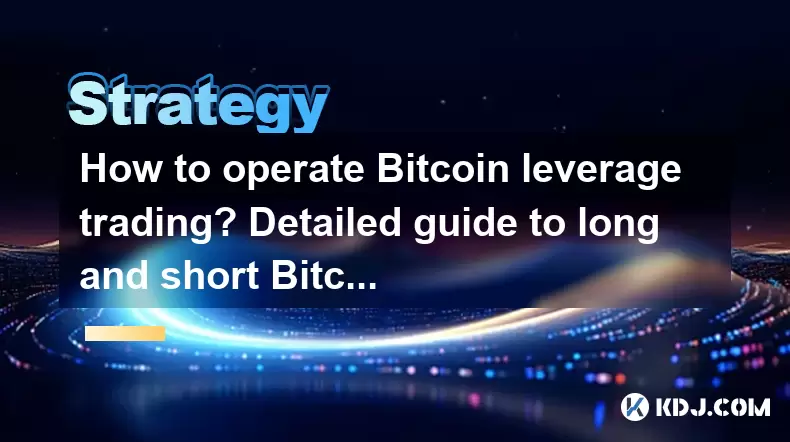-
 bitcoin
bitcoin $109547.008142 USD
0.04% -
 ethereum
ethereum $4011.838726 USD
-0.05% -
 tether
tether $1.000402 USD
-0.01% -
 xrp
xrp $2.798606 USD
0.88% -
 bnb
bnb $970.877944 USD
1.39% -
 solana
solana $202.237275 USD
-0.95% -
 usd-coin
usd-coin $0.999673 USD
0.00% -
 dogecoin
dogecoin $0.229294 USD
-1.15% -
 tron
tron $0.336370 USD
-0.45% -
 cardano
cardano $0.777260 USD
-1.66% -
 hyperliquid
hyperliquid $45.503019 USD
1.73% -
 ethena-usde
ethena-usde $1.000362 USD
0.01% -
 chainlink
chainlink $20.785303 USD
-1.10% -
 avalanche
avalanche $28.755822 USD
-0.11% -
 stellar
stellar $0.358303 USD
-0.48%
How to operate Bitcoin leverage trading? Detailed guide to long and short Bitcoin
Bitcoin leverage trading allows traders to amplify returns by borrowing funds, but it's crucial to manage risks due to potential significant losses.
Jun 12, 2025 at 03:00 pm

Bitcoin leverage trading offers traders the opportunity to amplify their potential returns by borrowing funds to increase their trading position. This guide will provide a detailed walkthrough of how to operate Bitcoin leverage trading, focusing on both long and short positions. By understanding the intricacies of leverage trading, you can make informed decisions and manage risks effectively.
Understanding Bitcoin Leverage Trading
Bitcoin leverage trading involves using borrowed funds to increase the size of your trading position. This can lead to higher profits if the market moves in your favor, but it also increases the potential for significant losses. Leverage is typically expressed as a ratio, such as 10:1, meaning you can control a position 10 times larger than your initial investment.
Leverage trading is not unique to Bitcoin; it is a common practice in traditional financial markets as well. However, the volatility of Bitcoin and other cryptocurrencies can make leverage trading particularly risky. It is essential to understand the mechanics of leverage trading before diving in.
Choosing a Trading Platform
To engage in Bitcoin leverage trading, you need to select a reliable trading platform that supports leveraged positions. Some popular platforms for cryptocurrency trading include Binance, Kraken, and BitMEX. Each platform has its own set of features, fees, and leverage options, so it's important to choose one that aligns with your trading strategy and risk tolerance.
- Research the platform's reputation and user reviews.
- Check the available leverage ratios and the fees associated with trading.
- Ensure the platform supports both long and short positions on Bitcoin.
Once you have selected a platform, you will need to complete the registration process, which typically involves providing personal information and verifying your identity. After your account is set up, you can deposit funds to begin trading.
Opening a Long Position on Bitcoin
A long position in Bitcoin leverage trading means you are betting that the price of Bitcoin will increase. Here's how to open a long position:
- Log into your chosen trading platform.
- Navigate to the Bitcoin trading section.
- Select the leverage ratio you want to use. For example, if you choose 10:1 leverage, you can control a position worth 10 times your initial investment.
- Enter the amount you wish to invest. If you are using $100 with 10:1 leverage, your position size will be $1,000.
- Set your entry price, which is the price at which you want to open your position.
- Set a stop-loss order to limit potential losses. This is a critical step in managing risk.
- Confirm the trade and monitor your position.
If the price of Bitcoin rises, your long position will generate profits. However, if the price falls, you could face significant losses, especially with high leverage.
Opening a Short Position on Bitcoin
A short position in Bitcoin leverage trading means you are betting that the price of Bitcoin will decrease. Here's how to open a short position:
- Log into your chosen trading platform.
- Navigate to the Bitcoin trading section.
- Select the leverage ratio you want to use. For example, if you choose 10:1 leverage, you can control a position worth 10 times your initial investment.
- Enter the amount you wish to invest. If you are using $100 with 10:1 leverage, your position size will be $1,000.
- Set your entry price, which is the price at which you want to open your position.
- Set a stop-loss order to limit potential losses.
- Confirm the trade and monitor your position.
If the price of Bitcoin falls, your short position will generate profits. However, if the price rises, you could face significant losses, especially with high leverage.
Managing Risk in Bitcoin Leverage Trading
Risk management is crucial in Bitcoin leverage trading due to the potential for rapid and significant price movements. Here are some strategies to manage risk:
- Use stop-loss orders to automatically close your position if the market moves against you.
- Diversify your trading portfolio to spread risk across different assets.
- Start with lower leverage ratios until you gain more experience and confidence.
- Regularly monitor your positions and be prepared to adjust them based on market conditions.
By implementing these risk management techniques, you can protect your capital and increase your chances of success in Bitcoin leverage trading.
Closing a Position
To close a position in Bitcoin leverage trading, you need to execute an opposite trade. If you have a long position, you will sell Bitcoin to close it. If you have a short position, you will buy Bitcoin to close it. Here's how to close a position:
- Log into your chosen trading platform.
- Navigate to the Bitcoin trading section.
- Locate your open position.
- Select the option to close the position.
- Confirm the trade to execute the closure.
Once your position is closed, any profits or losses will be reflected in your account balance. It's important to monitor your positions closely and be prepared to close them if the market moves against you.
Frequently Asked Questions
Q: What is the difference between margin trading and leverage trading in Bitcoin?A: Margin trading and leverage trading are often used interchangeably, but they refer to the same concept in the context of Bitcoin trading. Both involve borrowing funds to increase your trading position, with the borrowed funds acting as leverage to amplify potential returns.
Q: Can I lose more money than I initially invested in Bitcoin leverage trading?A: Yes, it is possible to lose more money than you initially invested in Bitcoin leverage trading. If the market moves against your position, the losses can exceed your initial investment, especially with high leverage. This is why risk management is crucial.
Q: What are the fees associated with Bitcoin leverage trading?A: Fees for Bitcoin leverage trading can vary depending on the trading platform. Common fees include trading fees, funding fees for holding leveraged positions overnight, and withdrawal fees. It's important to review the fee structure of your chosen platform before trading.
Q: How do I choose the right leverage ratio for Bitcoin trading?A: Choosing the right leverage ratio depends on your risk tolerance and trading strategy. Beginners should start with lower leverage ratios to minimize risk, while more experienced traders might opt for higher leverage to amplify potential returns. Always consider the potential for both gains and losses when selecting a leverage ratio.
Disclaimer:info@kdj.com
The information provided is not trading advice. kdj.com does not assume any responsibility for any investments made based on the information provided in this article. Cryptocurrencies are highly volatile and it is highly recommended that you invest with caution after thorough research!
If you believe that the content used on this website infringes your copyright, please contact us immediately (info@kdj.com) and we will delete it promptly.
- Crypto Whales, PEPE, and Meme Coins: What's the Hype?
- 2025-09-28 18:25:15
- Cathie Wood, Hyperliquid, and Solana Development: A New Era in Crypto?
- 2025-09-28 19:05:16
- Polkadot pUSD: NYC's Take on Decentralized Stability
- 2025-09-28 18:25:15
- Chainlink, Remittix, and Price Gains: A Tale of Two Cryptos
- 2025-09-28 19:05:16
- Altcoins, Portfolios, and Millions: Decoding the Crypto Bull Run
- 2025-09-28 19:10:01
- SWIFT, Ethereum, and Linea: Revolutionizing Global Banking?
- 2025-09-28 18:30:01
Related knowledge

Practical parameter settings for a Bitcoin multi-timeframe moving average system
Sep 18,2025 at 10:54pm
Optimizing Timeframe Combinations for Bitcoin Trading1. Selecting appropriate timeframes is crucial when building a multi-timeframe moving average sys...

How can I filter out false breakouts in Dogecoin high-frequency trading?
Sep 22,2025 at 01:00am
Understanding False Breakouts in Dogecoin Trading1. A false breakout occurs when Dogecoin's price appears to move beyond a defined support or resistan...

Techniques for identifying tops and bottoms in the Bitcoin on-chain NVT model
Sep 20,2025 at 07:54pm
Understanding the NVT Model in Bitcoin Analysis1. The Network Value to Transactions (NVT) ratio is often described as the 'P/E ratio' of the cryptocur...

What does the surge in open interest in Bitcoincoin futures mean?
Sep 20,2025 at 11:18pm
Understanding the Surge in Dogecoin Futures Open Interest1. A surge in open interest within Dogecoin futures indicates a growing number of active cont...

How can I use the Ethereum USDT premium to gauge market sentiment?
Sep 18,2025 at 11:55pm
Understanding the Ethereum USDT Premium1. The Ethereum USDT premium refers to the price difference between USDT (Tether) traded on Ethereum-based plat...

What should I do if Ethereum staking yields decline?
Sep 20,2025 at 06:18am
Understanding the Causes Behind Declining Ethereum Staking Yields1. The Ethereum network transitioned to a proof-of-stake consensus mechanism with the...

Practical parameter settings for a Bitcoin multi-timeframe moving average system
Sep 18,2025 at 10:54pm
Optimizing Timeframe Combinations for Bitcoin Trading1. Selecting appropriate timeframes is crucial when building a multi-timeframe moving average sys...

How can I filter out false breakouts in Dogecoin high-frequency trading?
Sep 22,2025 at 01:00am
Understanding False Breakouts in Dogecoin Trading1. A false breakout occurs when Dogecoin's price appears to move beyond a defined support or resistan...

Techniques for identifying tops and bottoms in the Bitcoin on-chain NVT model
Sep 20,2025 at 07:54pm
Understanding the NVT Model in Bitcoin Analysis1. The Network Value to Transactions (NVT) ratio is often described as the 'P/E ratio' of the cryptocur...

What does the surge in open interest in Bitcoincoin futures mean?
Sep 20,2025 at 11:18pm
Understanding the Surge in Dogecoin Futures Open Interest1. A surge in open interest within Dogecoin futures indicates a growing number of active cont...

How can I use the Ethereum USDT premium to gauge market sentiment?
Sep 18,2025 at 11:55pm
Understanding the Ethereum USDT Premium1. The Ethereum USDT premium refers to the price difference between USDT (Tether) traded on Ethereum-based plat...

What should I do if Ethereum staking yields decline?
Sep 20,2025 at 06:18am
Understanding the Causes Behind Declining Ethereum Staking Yields1. The Ethereum network transitioned to a proof-of-stake consensus mechanism with the...
See all articles









































































